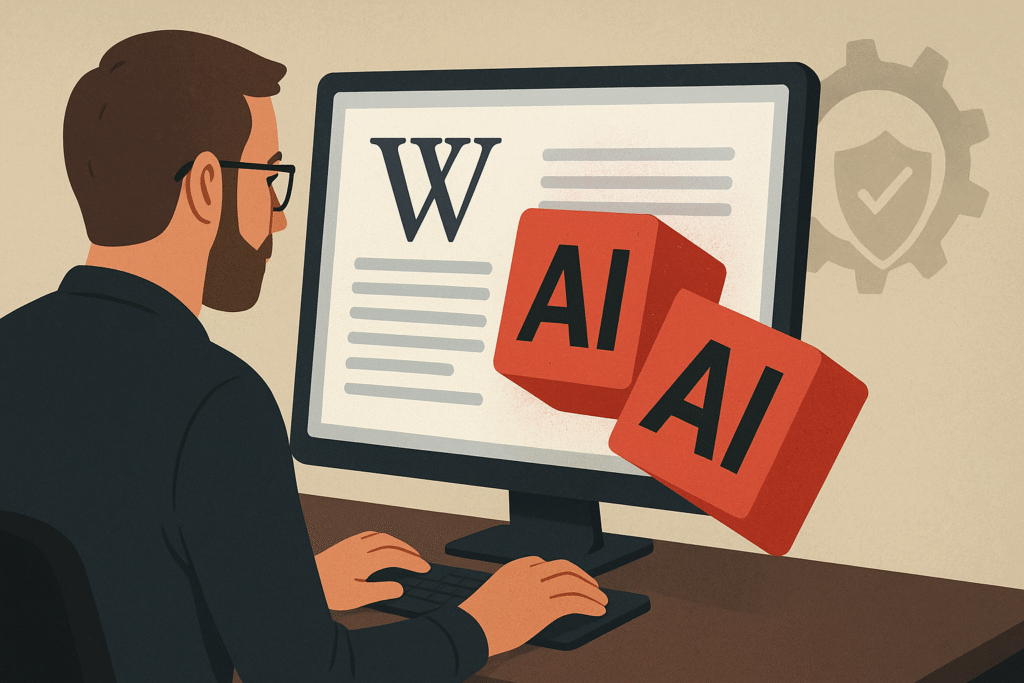In the last few years, AI slop content has emerged as a serious challenge for Wikipedia. As artificial intelligence tools become more accessible, they have unleashed an avalanche of AI generated articles riddled with false information, fabricated references, and clumsy writing. For a platform built on accuracy, neutrality, and community trust, this poses a direct threat to its credibility.
Wikipedia is not taking this lightly. The platform’s community driven immune system, as Wikimedia Foundation product director Marshall Miller describes it, has already adapted to counter this wave of misinformation. But how exactly are they doing it? And why is the fight against AI slop content more than just a technical battle it’s a fight for truth in the information age?
The Scope of the Problem: AI Slop Content Overload
AI tools can churn out thousands of words in minutes, but speed often comes at the cost of accuracy. Many AI written Wikipedia drafts arrive with.
Fake citations: references to books, studies, or articles that don’t exist.
Biased narratives: AI often mimics biased data from its training sources.
Poor readability: awkward phrasing and repetitive sentence structures.
A Wikipedia reviewer quoted by 404 Media described the experience. We are flooded non stop with horrendous drafts. It would greatly help efforts to combat it and save countless hours picking up the junk AI leaves behind.
The Speedy Deletion Rule in Action
Historically, articles flagged for deletion underwent a seven day community discussion to determine if they should remain online. While thorough, this process proved too slow for the new flood of AI generated junk. Now, with the newly adopted speedy deletion rule, Wikipedia administrators can bypass the week long debate if.
The article is clearly AI generated. The author did not manually review the AI’s work. The content contains obvious inaccuracies, fabrications, or poor structure. In June 2024, a page about a famous 18th century poet who never actually existed was posted. Within hours, moderators spotted fabricated book titles and citations, removed the article, and logged it as a speedy deletion case. This prevented hundreds of unnecessary editor hours from being wasted on cleanup.
Wikipedia’s Immune System at Work
Marshall Miller likens Wikipedia’s defense strategy to a biological immune system. They are vigilant to make sure that the content stays neutral and reliable. As the internet changes, as things like AI appear, that’s the immune system adapting to some kind of new challenge and figuring out how to process it.
Other experts emphasize that AI slop content detection is not just about spotting bad grammar it’s about verifying sources. According to digital misinformation researcher Dr. Karen Li from the University of Toronto. The most dangerous part of AI generated misinformation is not the typos it’s the convincingly fake citations. They give an illusion of credibility, which can trick even seasoned readers.
Personal Experiences From Wikipedia Editors
Veteran Wikipedia editor James Hartley shared his frustration. I once spent three hours tracing a reference in an AI generated article, only to realize the cited journal never existed. That’s three hours of volunteer time gone.
Another editor, known by their handle InfoGuardian, recounted how AI slop content often mixes real facts with subtle lies. The problem is, 80% of the article might be correct. But the 20% that’s wrong can completely distort the topic.
Wikipedia is more than just a website it’s one of the most visited sources of information in the world. According to SimilarWeb, it attracts over 6 billion visits per month. This means that AI slop content on Wikipedia could misinform millions of people, influencing everything from student research to public policy debates.
If AI generated misinformation spreads unchecked, the damage could extend to. Academic integrity Students citing false information in papers. Media reporting Journalists unknowingly repeating AI generated lies. Public perception Erosion of trust in online knowledge platforms.
How Wikipedia Is Adapting: A Multi Layered Defense
Even with AI detection tools, Wikipedia relies heavily on experienced human editors to catch inaccuracies. Wikipedia is experimenting with machine learning systems to flag suspicious content for faster review.
New editors are being trained to spot hallmarks of AI slop content, such as generic phrasing and unverifiable sources. Editors are encouraged to disclose if AI was used in drafting, ensuring accountability.
While speedy deletion is effective for obvious junk, some experts suggest that AI could still be a useful tool if paired with human oversight. As Dr. Li points out. AI is not inherently bad for Wikipedia. The danger comes from unreviewed AI text. When humans fact check and edit AI drafts, the result can be both accurate and efficient.
Wikipedia’s long term goal isn’t just to delete AI slop content it’s to ensure AI generated contributions meet the same high editorial standards as human written ones.
The Never Ending Battle for Truth
The fight against AI slop content is ongoing, but Wikipedia’s community driven immune system has proven resilient. By combining human expertise, faster deletion protocols, and AI detection tools, Wikipedia is setting a model for how online platforms can defend against the tidal wave of AI generated misinformation.
In a digital world where truth is under constant attack, Wikipedia’s battle is not just about cleaning up sloppy writing it’s about safeguarding the world’s knowledge for future generations.

